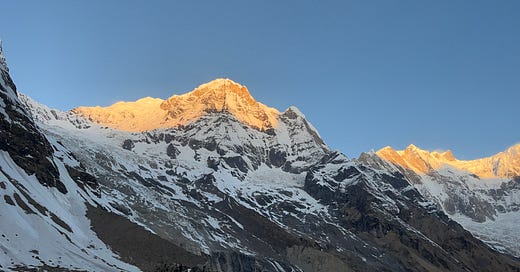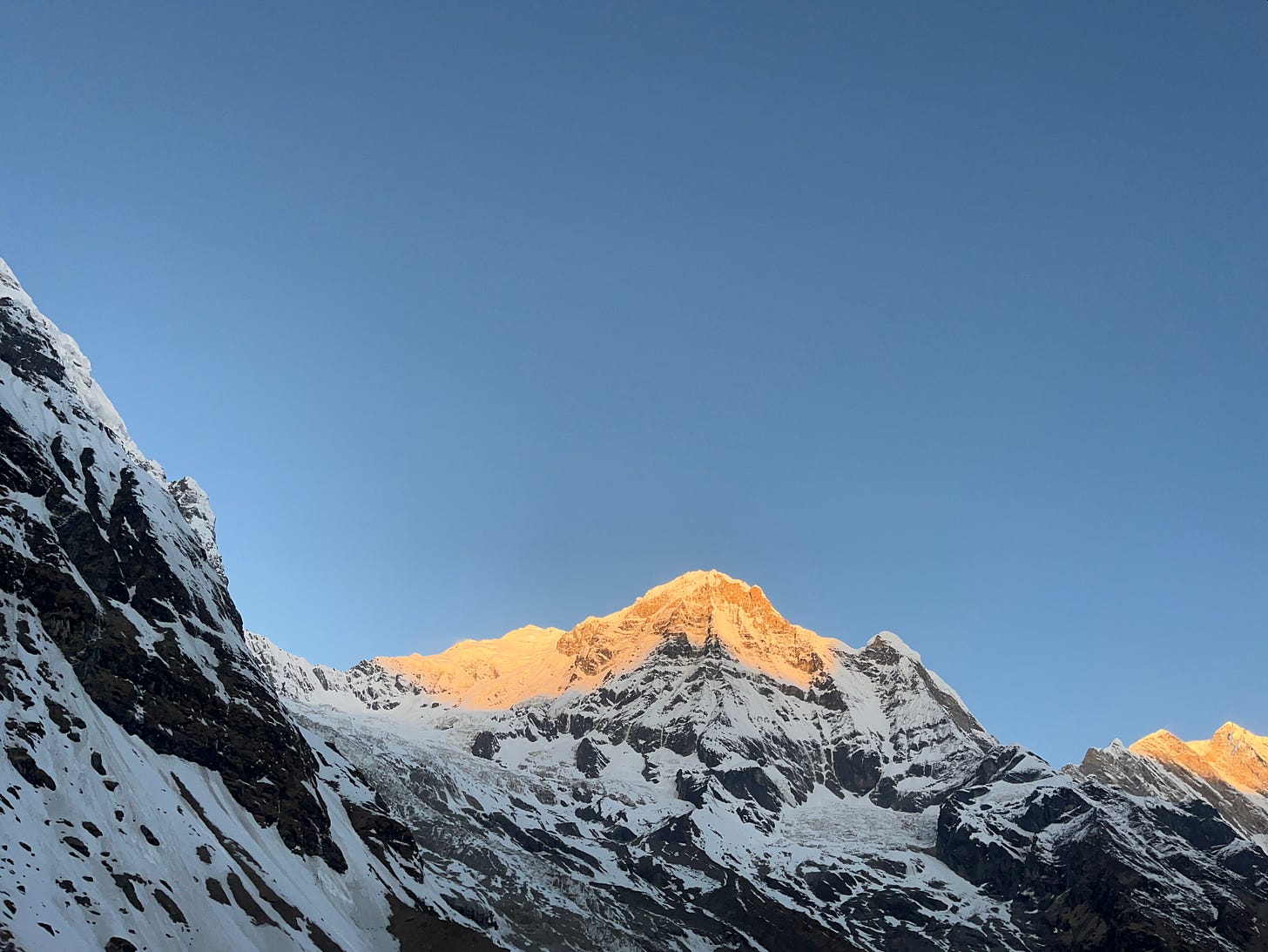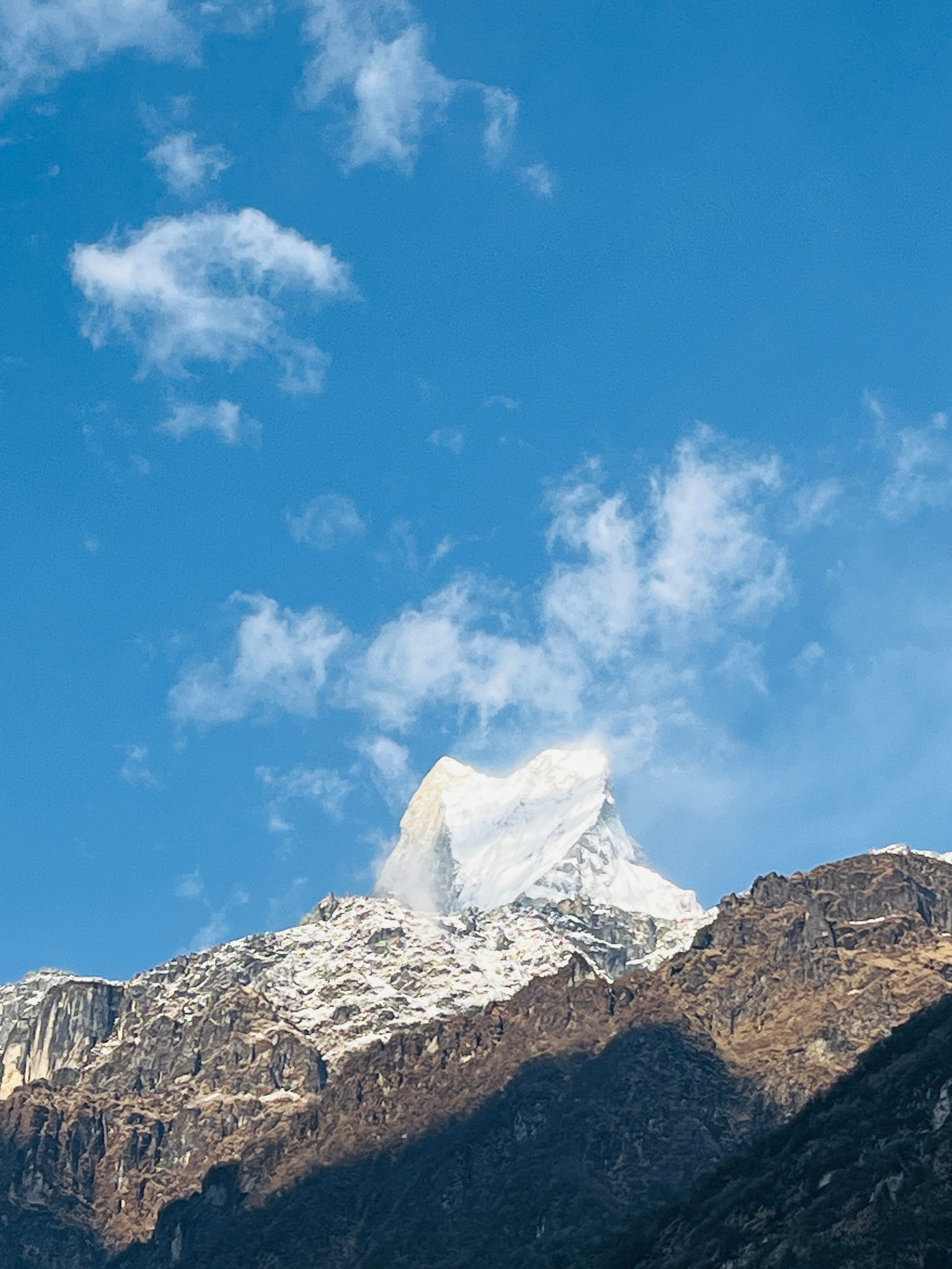Unfrozen: What Melts in the Mountains, and in Us
A journey through altitude, ambition, and the slow thaw of identity
❄️ Thaw Begins
Often, when I walk in the Himalayas, I imagine the brave souls who once set foot on the same path I now walk. While I may stop at base camp, they pushed through glaciers and crevasses, aiming for the summit. In 1992, on the slopes of Kangchenjunga, the great Polish climber Wanda Rutkiewicz vanished. She was attempting her ninth 8000-meter summit, hoping to become the first woman to climb all fourteen. At the altitude where she was last seen (around 8,300 meters), she would have been navigating what's known as the "death zone"—altitudes above 8,000 meters where oxygen levels are insufficient to sustain human life for extended periods. But she never returned. Her body was never found. Wanda lived at the edges of courage and obsession- the truth we will never know. It was as if the mountain took her in as a religious offering given by humankind.
Years before that, when Wanda became the first Polish climber—man or woman—to summit Everest, journalists rushed to make her gender the story. She refused. "I climb as a person, not a woman," she said. Her ambition was inward-facing, not driven by external validation. Wanda openly acknowledged her need for danger, framing it as the real power to her life, almost a life purpose.
This is not just an essay about the Himalayas or the people who climb them. It's about unfreezing—the slow, quiet process of letting go of fixed identities, rigid beliefs, and the stories we tell ourselves that we no longer need. Sometimes we melt. Sometimes, we stay frozen for a reason. This story is about how walking through mountains helped me see where I'd frozen and how I began to thaw through ambition, silence, danger, and company.
Wenda's story resonates with me; adventure almost powers one's life purpose. My call to adventure hasn't been through death-defying ascents—but through the steep climbs of building something new. As a leader, I've often sought out uncharted paths—starting a company, launching new initiatives, stepping into roles I wasn't sure I was ready for. And as an individual, I've found that trekking, though humbler than Wanda's summits, has its own silent power. I don't have her physical strength or altitude stamina. But each step in the Himalayas unfreezes thoughts I didn't know I'd buried. Something moves within me at the sights of those white-tipped peaks; something shifts inside, not gently but at speed. Somehow, I am shaken, not stirred.
🧗 Inner Climbs: Annapurna's Lessons
I found myself again in the Himalayas on my annual pilgrimage to these giants, this time on the trail to Annapurna Base Camp in Nepal, walking with 12 other fellow adventurers. There's something about moving in a group—strangers, acquaintances, old friends—that begins to thaw you in ways solo trekking doesn't. Conversations bloom in quiet climbs, laughter spills over lunch halts, and shared exhaustion opens small, unexpected windows into each other.
This time, it was Annapurna—the goddess mountain, the unpredictable one, known as much for her allure as her fury. She always puts me in my place and yet makes me feel taller. Harder. Softer. A bundle of contradictions, walking 75 kilometers across valleys and ridges. She always reminds me she is a teacher with shifting moods, a mirror to my inner climate as I walk. 'Annapurna' means 'Goddess of Nourishment'—providing food and sustenance. And yet, she is feared. She is wild, not tamed. In that paradox lies something essential: nourishment can come from disruption, not just comfort. Annapurna, in her many moods, seemed to say—'I may give you what you want but on my terms.' Annapurna is a massif containing several peaks. Annapurna I Main is the highest at 8,091 meters, making it the 10th highest mountain in the world. It has one of the highest fatality rates among all 8,000-meter peaks, with approximately 38% of climbers who attempt the mountain dying in the process (compared to about 4% on Everest).
And then there was Machhapuchhare. The fishtail peak. The one that never gets climbed—sacred, sharp, always slightly behind or beside you on the trail. A quiet companion. Rising to 6,993 meters (22,943 feet), Machapuchare is instantly recognizable for its distinctive fishtail shape, which gives the mountain its name ("Machha," meaning fish, and "Puchhre," meaning tail in Nepali)
Unlike Annapurna's tempestuousness, Machhapuchhare doesn't demand attention. It was always there while we were on our walk, watching us. There's something powerful about walking with a mountain you'll never conquer. One that remains unclimbed not because it's unclimbable—but because it's revered.
In 1957, a British expedition came within 150 meters of the summit. But out of respect for the mountain's sacred status in local belief—said to be the home of Lord Shiva—they turned back. Since then, Nepal has kept it off-limits to climbers. There are no flags or photos at the top. It is just a silhouette, iconic and untouched.
For days, Machhapuchhare was always there, just over my left shoulder. And I began to think of parts of myself like that—undisturbed, unclaimed, sacred even. What if some parts of us aren't meant to be 'worked on' or transformed—but simply honored? Walked beside. Respected in silence. What if transformation sometimes means not touching something?
As we walked from the warm, damp forests of Landruk & Doban into the colder conditions at both basecamps, MBC & ABC, the terrain shift felt like an emotional landscape shift. In the lower forests, you sweat. Yet, you chat. But mostly, you just climb steps, 1000s of them, in one never-ending sequence. The stairs on this route are awful; they force you to concentrate, letting slip the delight of a wandering mind when we walk in the mountains. And just as the concentration becomes too much, a friend walking with you pulls out a Mentos & offers you one, a much-wanted break from the tedium of one step after the other. But higher up, where you begin to feel the cold & silence, and the steps reduce in intensity, something else begins—stillness & reflection.
🔥 Melt Points: The Ice Within
And isn't that what change feels like? Your days are more of the same in the clutter of life, and only when pressured by fatigue or difficulties do you start to sense what's inside you, what's frozen, what's simmering. You begin in the noisy clutter of life, and only when you're stripped down by fatigue or height or silence do you begin to meet what's underneath.
Sometimes, I think what I'm working with isn't just metaphorical ice—but something closer to permafrost. It's not just surface-level frost that comes and goes with mood or season. But something deeper—soil that has stayed frozen for centuries. Permafrost is the earth holding onto memory. It stores organic matter, gases, and even ancient viruses—sealed in place, held in stillness. And when it thaws, everything changes. The soil shifts. Old things come to life. Others decay. It's not always beautiful. Sometimes, what emerges smells of rot, not renewal. But it is real. And it's movement. And that's the point.
I feel that way about certain parts of myself. Some parts of my ambition. Some definitions of love. Even the way I hold my body in a hug. These aren't conscious positions—I didn't wake up one day and decide to freeze them. They just settled that way. Layered, year by year.
To unfreeze them doesn't mean to break them apart. It means to let warmth in. Let gravity do its work. Let the old Thaw slowly release not just stories but maybe, eventually, something alive again.
To be frozen is to be held in place—set in stone, impervious to movement unless something external changes the temperature. For me, the mountains are the external agents that change my thermostat!
I had been thinking of identity. Not in the casual, label-driven way—but in the deeper, quieter way that sneaks up on you in transitions: Who am I now? Do I still want the same things? Am I playing a role I chose—or one that calcified while I wasn't looking?
The trek to Annapurna wasn't supposed to answer those questions. But somewhere between the controlled breathwork of the climb and the uninvited silence of the night, it began to reframe them.
Much of life's beauty occurs not when we hold steady but when we melt, when the freeze lifts.
I remember it was 1990. I was at my hungriest and very happy that I had a summer training at Procter & Gamble. It was my first day at Teicicon House, the headquarters of P&G then, and all of us summer trainees were jammed into the café where Gurcharan Das, the MD, was speaking to us. He must have said many things, but the only thing I retained was that P&G invests in summer trainees—and to the best among them, it gives pre-placement offers(PPO).
That line struck me like a lightning bolt. The idea of getting hired even before day one of MBA placements was a deep hit of external validation, and I fell for it, hook, line, and sinker.
I did good work on my project. But on the day of the final presentation, I froze. I was too hungry for the PPO to be calm. I still remember TV Krishnamurti's cabin where we were all presenting, the round glass table, around which people were sitting. My palms were wet, I was not speaking fluently & was visibly perturbed. I stumbled through the slides. People were smiling at my nervousness. At one point, my boss even asked if I was feeling unwell or needed medication & he offered me a glass of water. It was one of those moments where I had no grace under pressure.
And yet—to my complete surprise—I got that PPO.
That experience taught me something I would only understand years later: freezing an outcome does me no good. Wanting the summit too badly makes you less effective. When you become too emotionally loaded with the result—when everything depends on that single moment—you stop flowing, you stop being present. Ironically, that very attachment is what freezes you.
Years later, I see the pattern in other parts of life, too: when the summit becomes the only thing that matters, the journey stiffens. Sometimes, letting go is the only way to stay in rhythm with yourself.
That moment in Krishnamurti's cabin taught me more than a PPO could. It taught me that we freeze not just from fear—but from wanting too much. And years later, in the shadow of Annapurna, I could feel that same freeze slowly softening. One step at a time.
I wonder what freeze you've carried too long. Is it ambition? Or the fear of what letting go might melt?
(Continued in Part 2…next, I'll explore how other mountain treks revealed deeper layers of my frozen self, the connections between pain, praise, and identity, and how small acts of unfreezing can gradually transform our relationship with ourselves and others. I'll also share stories of other legendary climbers whose experiences on Annapurna and beyond offer profound insights about identity and purpose)







Fabulous piece, Ajay. Very thought provoking. Started marking out sentences I liked to highlight in my comment and then stopped after the fifth sentence. Loved all of it.
Loved this so much!
Thanks for writing! ❤️